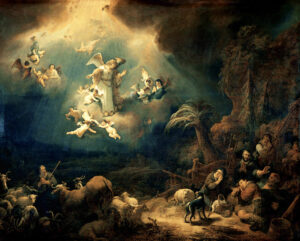



नमस्ते,

The date of birth of Jesus is not stated in the gospels or in any historical sources, but most biblical scholars generally accept a date of birth between 6 BC and 4 BC, the year in which King Herod died.The historical evidence is too incomplete to allow a definitive dating, but the year is estimated through three different approaches:
-
analysing references to known historical events mentioned in the nativity accounts in the Gospels of Luke and Matthew,
-
working backward from the estimation of the start of the ministry of Jesus,and
-
astrological or astronomical alignments.
The common Christian traditional dating of the birthdate of Jesus was 25 December, a date first asserted officially by Pope Julius I in 350 AD, although this claim is dubious or otherwise unfounded. The day or season has been estimated by various methods, including the description of shepherds watching over their sheep.
In the third century, the date of birth of Jesus was a subject of great interest, with early Christian writers suggesting various dates. Around AD 200, Clement of Alexandria wrote:

The Angel Appearing to the Shepherds, Govert Flinck, 1639. The presence of the shepherds is important in determining the date of Jesus’s birth.
The early Christian writer Lactantius wrote “the east is attached to God because he is the source of light and the illuminator of the world and he makes us rise toward eternal life”. It is for this reason that the early Christians established the direction of prayer as being eastward, towards the rising sun.A late fourth-century sermon by Saint Augustine explains why the winter solstice was a fitting day to celebrate Christ’s birth:
There are those who have determined not only the year of our Lord’s birth, but also the day; and they say that it took place in the 28th year of Augustus, and in the 25th day of [the Egyptian month] Pachon [May 20] […] Further, others say that He was born on the 24th or 25th of Pharmuthi [April 20 or 21].
Hence it is that He was born on the day which is the shortest in our earthly reckoning and from which subsequent days begin to increase in length. He, therefore, who bent low and lifted us up chose the shortest day, yet the one whence light begins to increase.
Two competing theories
Two main theories have been offered as to the choice of date.
Calculation hypothesis
Further information: Chronology of Jesus
Steven Hijmans of the University of Alberta wrote: “It is cosmic symbolism […] which inspired the Church leadership in Rome to elect the southern solstice, December 25, as the birthday of Christ, and the northern solstice as that of John the Baptist, supplemented by the equinoxes as their respective dates of conception”. The Christian treatise De solstitia et aequinoctia conceptionis et nativitatis Domini nostri Iesu Christi et Iohannis Baptistae (‘On the solstice and equinox conception and birth of Our Lord Jesus Christ and John the Baptist’), from the second half of the fourth century,dates John’s birth to the summer solstice and Jesus’s birth to the winter solstice.
The “Calculation hypothesis”, suggests that Christmas was calculated as nine months after a date chosen as Jesus’s conception (the Annunciation): March 25, the Roman date of the spring equinox. The hypothesis was first proposed by French writer Louis Duchesne in 1889. Susan Roll (1995) wrote that the calculation hypothesis is historically the “minority opinion” on the origin of Christmas, but was “taught in graduate liturgy programs as a thoroughly viable hypothesis”.[22]
In AD 221, Sextus Julius Africanus named March 25, the traditional spring equinox, as the day of creation and of Jesus’s conception. While this implies a birth in December, Africanus did not offer a birth date for Jesus, and he was not an influential writer at the time.
Some early Christians marked Jesus’s crucifixion on a date they deemed equivalent to the 14th of Nisan, the day before Passover in the Hebrew calendar. This feast was referred to as the Quartodeciman (Latin for ‘fourteenth’). Some early Christian writers equated the 14th of Nisan with the equinox on March 25, and made the date of his conception or birth the same as that of his death.Duchesne conjectured that Jesus was thought to have been born and died on the same day, so lived a whole number of years, “since symbolic number systems do not permit the imperfection of fractions”. However, he admitted that this theory is not supported by any early Christian text.
Adam C. English, professor of religion at Campbell University, has argued for the veracity of December 25 as Jesus’s date of birth. The Bible in Luke 1:26 records the annunciation to Mary to be at the time when Elizabeth, mother of John the Baptist, was in her sixth month of pregnancy. English assumes that Zechariah’s ministry in the Temple, as described in Luke 1:5–23, took place on Yom Kippur the year before Jesus’s birth; he then traces the narrative in the Gospel of Luke through the Annunciation and the birth of John the Baptist to conclude that Jesus was born on December 25. The earliest evidence for the Feast of the Annunciation (or Incarnation) is from the sixth century.
Susan Roll questions whether “ordinary Christians in the third and fourth centuries [were] much interested in calculations with symbolic numbers”. Likewise, Gerard Rouwhorst believes it is unlikely that feasts emerged “on the basis of calculations by exegetes and theologians”, arguing “For a feast to take root in a community more is needed than a sophisticated computation”.
History of religions hypothesis
Theology professor Susan Roll claims that “No liturgical historian […] goes so far as to deny that it has any sort of relation with the sun, the winter solstice and the popularity of solar worship in the later Roman Empire”. Related to the winter solstice theory, the “History of Religions” hypothesis proposes the Church chose December 25 as Jesus’s birthday (dies Natalis Christi) to appropriate the Roman winter solstice festival dies Natalis Solis Invicti (‘birthday of the Unconquered Sun’), held on the same date.It honored the sun god Sol Invictus, whose cult was revived by the emperor Aurelian in AD 274. In Rome this yearly festival was celebrated with thirty chariot races. Gary Forsythe, Professor of Ancient History, says “This celebration would have formed a welcome addition to the seven-day period of the Saturnalia (December 17–23), Rome’s most joyous holiday season since Republican times, characterized by parties, banquets, and exchanges of gifts”.In AD 362, the emperor Julian wrote in his Hymn to King Helios that the Agon Solis was a festival of the sun held at the end of the Saturnalia in late December.
A Christian treatise attributed to John Chrysostom and dating to the early fourth century AD associates Jesus’s birth with the birthday of Sol:
Our Lord, too, is born in the month of December […] the eighth before the calends of January [25 December] […] But they [the pagans] call it the ‘Birthday of the Unconquered‘. Who indeed is so unconquered as Our Lord? Or, if they say that it is the birthday of the Sun, [we may say] He is the Sun of Justice.
The theory is mentioned in an annotation of uncertain date added to a manuscript by 12th-century Syrian bishop Jacob Bar-Salibi. The scribe wrote:
It was a custom of the Pagans to celebrate on the same 25 December the birthday of the Sun, at which they kindled lights in token of festivity. In these solemnities and revelries, the Christians also took part. Accordingly, when the doctors of the Church perceived that the Christians had a leaning to this festival, they took counsel and resolved that the true Nativity should be solemnised on that day.
In the 17th century, Isaac Newton, who, coincidentally, was born on December 25, suggested the date of Christmas was chosen to correspond with the winter solstice. In 1743, German scholar Paul Ernst Jablonski argued the date was chosen to correspond with the Natalis Solis Invicti.The hypothesis was first developed substantially by fellow German scholar Hermann Usener in 1889 and adopted by many scholars thereafter.
Steven Hijmans of the University of Alberta says the idea that the date was chosen to appropriate the pagan festival “has received wide acceptance”. He agrees that the Church chose the date because it was the winter solstice, but he argues that “While they were aware that pagans called this day the ‘birthday’ of Sol Invictus, this did not concern them and it did not play any role in their choice of date for Christmas”. Hijmans says: “while the winter solstice on or around December 25 was well established in the Roman imperial calendar, there is no evidence that a religious celebration of Sol on that day antedated the celebration of Christmas”. Thomas Talley argues that Aurelian instituted the Dies Natalis Solis Invicti partly to give a pagan significance to a date he argues was already important for Christians. The Oxford Companion to Christian Thought remarks that the “calculations hypothesis potentially establishes 25 December as a Christian festival before Aurelian’s decree”.
According to C. Philipp E. Nothaft, a professor at Trinity College Dublin, though the history of religions hypothesis “is nowadays used as the default explanation for the choice of 25 December as Christ’s birthday, few advocates of this theory seem to be aware of how paltry the available evidence actually is.”
नमस्ते
merry christmas
आपका सेवक-लेखक
Narendra Vala
[Vicky Rana]
‘Satya Ki Shodh’

